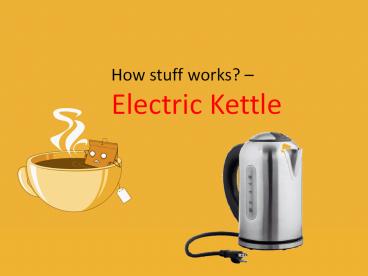How stuff works of your electric kettle - PowerPoint PPT Presentation
Title:
How stuff works of your electric kettle
Description:
There’s nothing as simple and comforting as putting on the electric kettle and sitting down with a hot cuppa. The science behind how electric kettle works is really quite straightforward too. – PowerPoint PPT presentation
Number of Views:857
Title: How stuff works of your electric kettle
1
How stuff works? Electric Kettle
2
Theres nothing as simple and comforting as
putting on the kettle and sitting down with a hot
cup of tea. The science behind how it works is
really quite straightforward too.
In part three of our how stuff works series, we
take a look at how electricity powers our kettles.
3
A Brief History When gas cook-tops became more
widely available around 100 years ago, the
whistling electric kettle, otherwise known as a
steam electric kettle became a popular kitchen
appliance. The premise was simple, water in the
kettle would boil, building pressure which was
forced through the lid, releasing a high pitched
whistle.
By 1922, steam kettles were replaced with
electric kettles, invented by Arthur Leslie.
4
Russell Hobbs then manufactured their K2 electric
kettle in 1959, which featured a cool-touch
handle and lid, preventing people from burning
their hands3.
5
If youve ever wondered how kettles work, were
going to break it down for you. Inside each
electric Kettle is a metal coil. Electrical
energy travels through the coil, turning into
heat and warming the cold water inside it.
Works
How it
6
- The process looks a little something like this
- When the kettle is turned on, a large electric
current flows through the coil, or the heating
element. - The coil has an electrical resistance (a measure
of the difficulty to pass an electric current
through it). This resistance turns electrical
energy into heat as it passes through coil. - The heat brings the water inside it to boiling
point. - Some electric kettles use a thermostat, which
prompts them to switch off when the water reaches
the right temperature.
7
How To Save Energy By Using Electric Kettle More
Efficiently?
Kettles are already 50 more efficient than
stovetops when it comes to boiling water, but you
could save even more energy by avoiding these
three common mistakes
- Your kettle will work harder if youre filling
it with large amounts of water. Save on energy by
only using as much water as you need. - Forgetting to turn off kitchen appliances can
add up to 5 of your energy bill. Save on standby
power by switching off after every use. - Sometimes, your appliances just need a little
TLC. If you dont clean your kettle often, you
might see a build up of limescale. Remember to
clean it at least once a month. This will keep it
in good order.
8
Find More Energy Efficiency Best Electric Kettle
www.BestElectricKettle.Co.Uk

